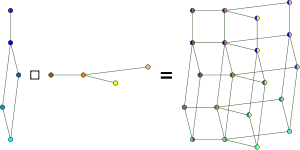Cartesian product of graphs

In graph theory, the Cartesian product G  H of graphs G and H is a graph such that
H of graphs G and H is a graph such that
- the vertex set of G
 H is the Cartesian product V(G) × V(H); and
H is the Cartesian product V(G) × V(H); and - any two vertices (u,u') and (v,v') are adjacent in G
 H if and only if either
H if and only if either
- u = v and u' is adjacent with v' in H, or
- u' = v' and u is adjacent with v in G.
Cartesian product graphs can be recognized efficiently, in time O(m log n) for a graph with m edges and n vertices (Aurenhammer, Hagauer & Imrich 1992). The operation is commutative as an operation on isomorphism classes of graphs, and more strongly the graphs G  H and H
H and H  G are naturally isomorphic, but it is not commutative as an operation on labeled graphs. The operation is also associative, as the graphs (F
G are naturally isomorphic, but it is not commutative as an operation on labeled graphs. The operation is also associative, as the graphs (F  G)
G)  H and F
H and F  (G
(G  H) are naturally isomorphic.
H) are naturally isomorphic.
The notation G × H is occasionally also used for Cartesian products of graphs, but is more commonly used for another construction known as the tensor product of graphs. The square symbol is the more common and unambiguous notation for the Cartesian product of graphs. It shows visually the four edges resulting from the Cartesian product of two edges.[1]
The Cartesian product is not a product in the category of graphs. (The tensor product is the categorical product.) However, it is a product in the category of reflexive graphs. The category of graphs does form a monoidal category under the Cartesian product.
Examples
- The Cartesian product of two edges is a cycle on four vertices: K2
 K2 = C4.
K2 = C4. - The Cartesian product of K2 and a path graph is a ladder graph.
- The Cartesian product of two path graphs is a grid graph.
- The Cartesian product of n edges is a hypercube:
-
- Thus, the Cartesian product of two hypercube graphs is another hypercube: Qi
 Qj = Qi+j.
Qj = Qi+j.
- The Cartesian product of two median graphs is another median graph.
- The graph of vertices and edges of an n-prism is the Cartesian product graph K2
 Cn.
Cn. - The rook's graph is the Cartesian product of two complete graphs.
Properties
If a connected graph is a Cartesian product, it can be factorized uniquely as a product of prime factors, graphs that cannot themselves be decomposed as products of graphs (Sabidussi 1960; Vizing 1963). However, Imrich and Klavžar (2000) describe a disconnected graph that can be expressed in two different ways as a Cartesian product of prime graphs:
- (K1 + K2 + K22)
 (K1 + K23) = (K1 + K22 + K24)
(K1 + K23) = (K1 + K22 + K24)  (K1 + K2),
(K1 + K2),
where the plus sign denotes disjoint union and the superscripts denote exponentiation over Cartesian products.
A Cartesian product is vertex transitive if and only if each of its factors is (Imrich and Klavžar, Theorem 4.19).
A Cartesian product is bipartite if and only if each of its factors is. More generally, the chromatic number of the Cartesian product satisfies the equation
- χ(G
 H) = max {χ(G), χ(H)}
H) = max {χ(G), χ(H)}
(Sabidussi 1957). The Hedetniemi conjecture states a related equality for the tensor product of graphs. The independence number of a Cartesian product is not so easily calculated, but as Vizing (1963) showed it satisfies the inequalities
- α(G)α(H) + min{|V(G)|-α(G),|V(H)|-α(H)} ≤ α(G
 H) ≤ min{α(G) |V(H)|, α(H) |V(G)|}.
H) ≤ min{α(G) |V(H)|, α(H) |V(G)|}.
The Vizing conjecture states that the domination number of a Cartesian product satisfies the inequality
- γ(G
 H) ≥ γ(G)γ(H).
H) ≥ γ(G)γ(H).
Algebraic graph theory
Algebraic graph theory can be used to analyse the Cartesian graph product.
If the graph  has
has  vertices and the
vertices and the  adjacency matrix
adjacency matrix  , and the graph
, and the graph  has
has  vertices and the
vertices and the  adjacency matrix
adjacency matrix  , then the adjacency matrix of the Cartesian product of both graphs is given by
, then the adjacency matrix of the Cartesian product of both graphs is given by
-
 ,
,
where  denotes the Kronecker product of matrices and
denotes the Kronecker product of matrices and  denotes the
denotes the  identity matrix.[2]
identity matrix.[2]
History
According to Klavžar and Imrich, Cartesian products of graphs were defined in 1912 by Whitehead and Russell. They were repeatedly rediscovered later, notably by Sabidussi in 1960.
Notes
- ↑ Hahn, Geňa; Sabidussi, Gert (1997), Graph symmetry: algebraic methods and applications, NATO Advanced Science Institutes Series 497, Springer, p. 116, ISBN 978-0-7923-4668-5.
- ↑ Kaveh, A.; Rahami, H. (2005), "A unified method for eigendecomposition of graph products", Communications in Numerical Methods in Engineering with Biomedical Applications 21 (7): 377–388, doi:10.1002/cnm.753, MR 2151527.
References
- Aurenhammer, F.; Hagauer, J.; Imrich, W. (1992). "Cartesian graph factorization at logarithmic cost per edge". Comput. Complexity 2 (4): 331–349. doi:10.1007/BF01200428. MR 1215316.
|first4=missing|last4=in Authors list (help) - Imrich, Wilfried; Klavžar, Sandi (2000). Product Graphs: Structure and Recognition. Wiley. ISBN 0-471-37039-8.
- Imrich, Wilfried; Klavžar, Sandi; Rall, Douglas F. (2008). Graphs and their Cartesian Products. A. K. Peters. ISBN 1-56881-429-1.
- Sabidussi, G. (1957). "Graphs with given group and given graph-theoretical properties". Canad. J. Math. 9: 515–525. doi:10.4153/CJM-1957-060-7. MR 0094810.
- Sabidussi, G. (1960). "Graph multiplication". Math. Z. 72: 446–457. doi:10.1007/BF01162967. MR 0209177.
- Vizing, V. G. (1963). "The Cartesian product of graphs". Vycisl. Sistemy 9: 30–43. MR 0209178.
